CHAPTER 02
World Heritages
THE NIGHT SKY IS A TIME MACHINE AND SO IS ARCHAEOLOGY. THE NIGHT SKY STAYS ETERNAL ABOVE OUR FLASHING CIVILIZATIONS.
More than 1,000 sites are protected under the UNESCO World Heritage programme, the large majority of them dating back thousands of years. Some are far enough away from light pollution that today’s onlookers can experience much the same vision of the natural night sky as that seen by our ancestors when they built these magnificent landmarks. That is the common theme for a number of the photographs in this chapter – just as the monuments speak to history, to ancient learning and much more, these captured skies allow us to contemplate the ancient ‘landmarks’ of the night sky. The skies above these iconic and important heritage sites resonate with the viewer on an instinctive level – they spark the imagination. Not only do they reveal the true beauty of the night sky within a protected environment, but they showcase some of the world’s most familiar, iconic sites in a less familiar light.
In a world in which the lights of urbanization have, for many, overwhelmed the natural light of our skies, The World at Night programme provides viewers with more meaningful experiences of these heritage sites. Bringing the stars and the ancient monuments together within single frames, these carefully curated photographs reconnect us with the importance of the night sky to early civilization. It is in this context that we start to see the night sky as being blended with archaeology. Through stargazing and capturing vistas at historic sites, a bond is created between these ancient stars and sacred grounds. Just as archaeology acts as a time machine, digging into the buried practices and geography of our history, the night sky, too, is a living time machine. Due to light speed and cosmic distances, celestial objects visible to the naked eye take us back in time anywhere from one second (the moon) to 2.5 million years ago (the Andromeda Galaxy), when the first human ancestors appeared in Africa.

Moscow RUSSIA
The moon hangs low in the sky next to the Cathedral of Christ the Saviour in this summer evening twilight overlooking the Moskva River and the Kremlin (right) near Red Square.
The first few pages of this chapter consider World Heritage sites with links to archaeoastronomy, a young science that studies sites in relation to the sky. Stonehenge in the United Kingdom, Mexico’s Chichén Itzá and the Mesopotamian ziggurats of the Middle East are lasting evidence of places where ancient stargazers used celestial figures and solar and lunar motion to keep track of time for both ritual and agricultural purposes. While they bear no resemblance to the observatories of today’s science practices, these ancient calendar-keeping monuments represent the birth of astronomy. Such monuments exist on all of the world’s inhabited continents, conceived by every major civilization as a means of tracking time. In North America, Chaco Canyon in New Mexico is one such destination, at one time inhabited by the Ancient Pueblos. Now a national park, the site is home to a hand-moon-star pictograph that could well represent the configuration of the new moon and a supernova recorded in the year 1054 – this was the explosion of a star much bigger than the sun, far in our galaxy, which glowed like a bright new star in the Earth’s sky for around two years.
From a high desert in New Mexico to a green valley of giant natural rock pillars in Europe: perched atop a series of tall and delicately thin rocks in Metéora, Greece, are ancient monasteries. Incredibly isolated, these are truly unique places from which to appreciate the stars, exactly as they have appeared to the thousands of monks who have lived here since the eleventh century. A little further south of Metéora sits one of the most impressive symbols of Western civilization, on a steep rocky hill overlooking Athens. The Acropolis witnessed the emergence of classical Greek thought and art, a time when Socrates’ philosophy was formed and when the first Academy was founded by Plato in 387 [BCE].
More than 13,000 km (8,000 miles) away, at the heart of Australia, Uluru – an immense monolith – towers 348 m (1,142 ft) above the surrounding desert and extends some ten times further underground. It has been home to settlements for more than 10,000 years. Uluru National Park is peppered with ancient rock art recounting stories of the creation of the land and skies. Many celestial stories can be found in ancient petroglyphs and pictographs around the world – the exhibits of open-air galleries, often far from city lights, beneath an ocean of stars on moonless nights.
Journeying from the deserts of Australia and across the waters of the Indian Ocean, some 8,000 km (4,900 miles) west, almost half of an island near Madagascar is protected by the World Heritage programme. This is Réunion, a land of erupting volcanoes, subtropical rainforests and truly dark skies that appear almost to rest on the mountains above the cloud forests.
Although the foreground is an important element in all of these images, to a nightscape photographer, the sky always forms the main story. This chapter is, perhaps, the most unique in the essential planning that is necessary for the capture of these images – sometimes many months in advance. A good knowledge of the night sky and practical astronomy is critical, to ensure the photographer is ‘in the right place, at the right time’. While ideal weather and moonlight conditions are the primary focuses of that planning, other factors include geographic location, altitude and temperature, local topography and light pollution. In the case of many World Heritage sites, there is the added complication of limited access – rightly so, given the protected status of these historic landmarks. These various elements combine to provide more resonance to the unique story each photograph has to convey – the story of the eternal night sky above our flashing civilizations.
ASTRONOMY
UNESCO’s Heritage of Astronomy initiative has listed around 100 historic or ancient sites as having notable connections to practical astronomy. Some are those observatories in which groundbreaking discoveries have been made during the last few centuries, such as Mount Wilson in Los Angeles, California, where Edwin Hubble proved the existence of galaxies beyond the Milky Way and later discovered the expansion of the universe. Other sites are pre-telescopic observatories, where early astronomers used massive angular-measurement devices to track the movement of the stars more accurately than could be achieved with the naked eye. These include the Maragheh and Ulugh Beg observatories of the medieval Islamic world, in modern-day Iran and Uzbekistan respectively; the Beijing Ancient Observatory, China; and Tycho Brahe’s Uraniborg observatory in Denmark. More primitive sites take us back to the very dawn of science, when astronomy was used to create calendars for farming and social rituals. Some of the rock art in Lascaux Cave in France, now 17,000 years old, shows abstract designs associated with seasonal animals that may relate to astronomical calendars. It is thought that some examples here show the earliest known constellation and asterism figures. Above an aurochs, a cluster of dots resembles the the Pleiades (Seven Sisters), while the animal’s eye and surrounding dots resemble bright star Aldebaran and the Hyades star cluster, both part of Taurus (the Bull) constellation.
Prehistoric stone circles are known across the globe. There are as many as 1,000 sites in total, the oldest of which dates back 10,000 years. Reasons for their construction vary. Some served as burial grounds for notable members of society, others as centres for ceremonial gatherings. In many cases, the positions of the stones relate to specific celestial observations, marking events in the lunar and solar calendar, such as equinoxes and summer solstices. One of the most spectacular examples of this is Stonehenge, just 100 km (60 miles) west of London, in the United Kingdom. Astronomical alignments are found in many other monuments of the ancient world, from pre-Columbian Mayan temples, such as those at Chichén Itzá in Mexico, to the Pyramids of Giza in Egypt and the Taosi archaeological site in China’s Shanxi province.

Beijing CHINA
Beijing shows its stars on an exceptionally clear evening. A long combined exposure captures the journey made by the moon, Mars, Venus and other stars as they cross from the night sky above Jiao Lou tower in the Forbidden City, and trail down to the western horizon. This site served as the home of emperors for almost 500 years. The colour of the moon shifts to yellow as it approaches the hazy horizon.

Stonehenge, Wiltshire ENGLAND
The most architecturally sophisticated prehistoric stone circle in the world, Stonehenge is a testament to the skills of ancient peoples. It has long been recognized as a site of astronomical significance. Most notably, it is aligned along the midwinter sunset–midsummer sunrise solstitial axis. The main construction started 5–6,000 years ago and saw some 2,000 years of continuous monument building from 3700 to 1600 [BCE]. This photograph, taken in April 1997, captures the moment at which Comet Hale-Bopp, one of the greatest comets of our time, flew above this historic landmark. Intriguingly, it is thought that the comet’s last appearance above Earth coincided with an early development phase of Stonehenge, some 4,200 years earlier. The comet is expected to return to the inner solar system around the year 4385. As such, this celestial phenomenon is inextricably linked to our ancient past, but also to our far distant future.
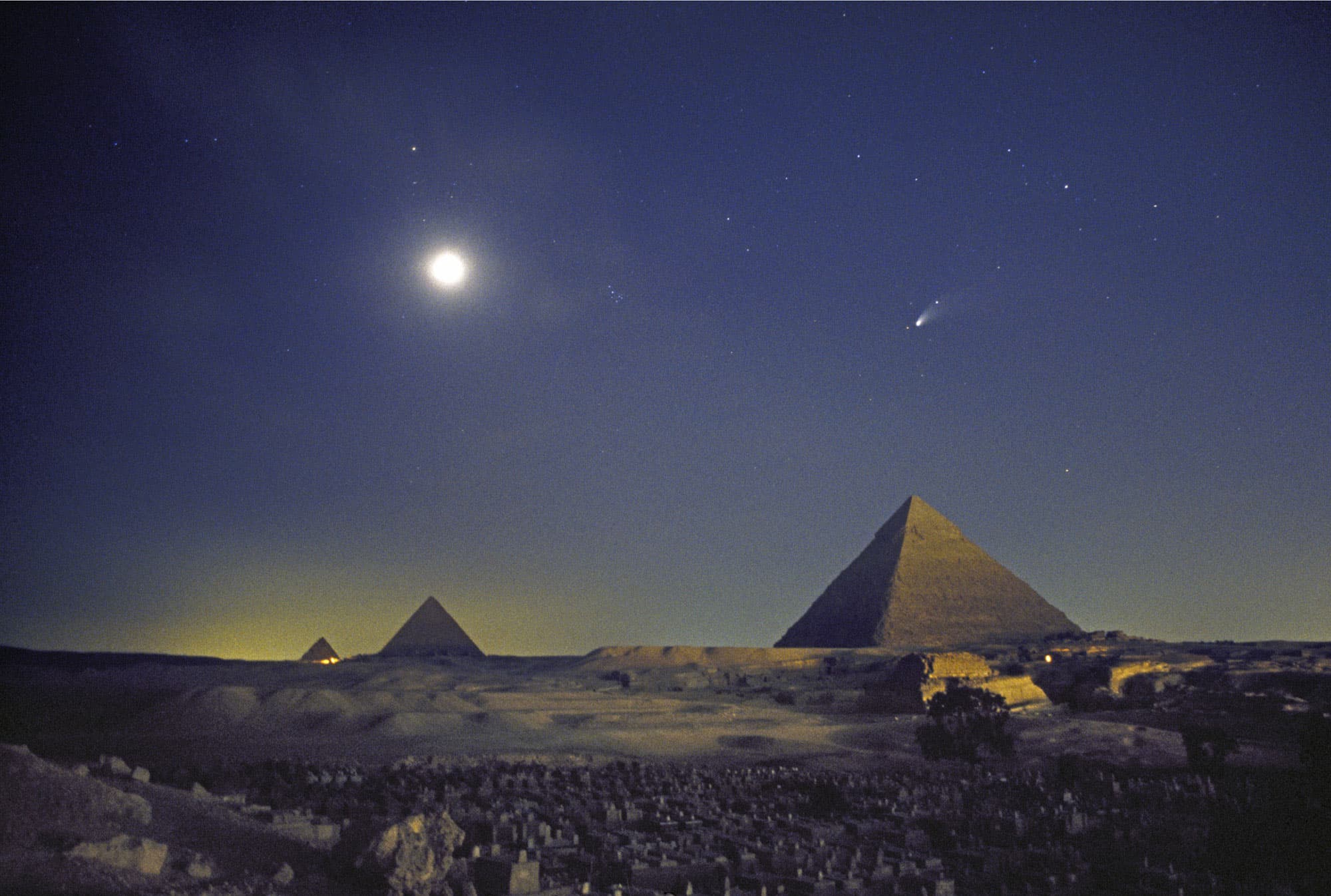
Pyramids of Giza, Cairo EGYPT
Above the Pyramids of Giza, the moon and stars of constellations Taurus and Perseus share the night sky with Comet Hale-Bopp as it travels past Earth. Photographed on the outskirts of Cairo in April 1997, this was one of the brightest comets of our time – so bright, that it was easily visible from metropolitan areas in spite of city light pollution. The comet’s previous encounter with Earth coincided with the completion of these pyramids, built on the Nile River between 2589 and 2530 [BCE]. The three main pyramids are orientated to the cardinal directions with remarkable precision. For such monumental structures, this could only have been achieved through astronomical observation. What an extraordinary sight the appearance of this bright comet must have been for those ancient astronomers of Giza.
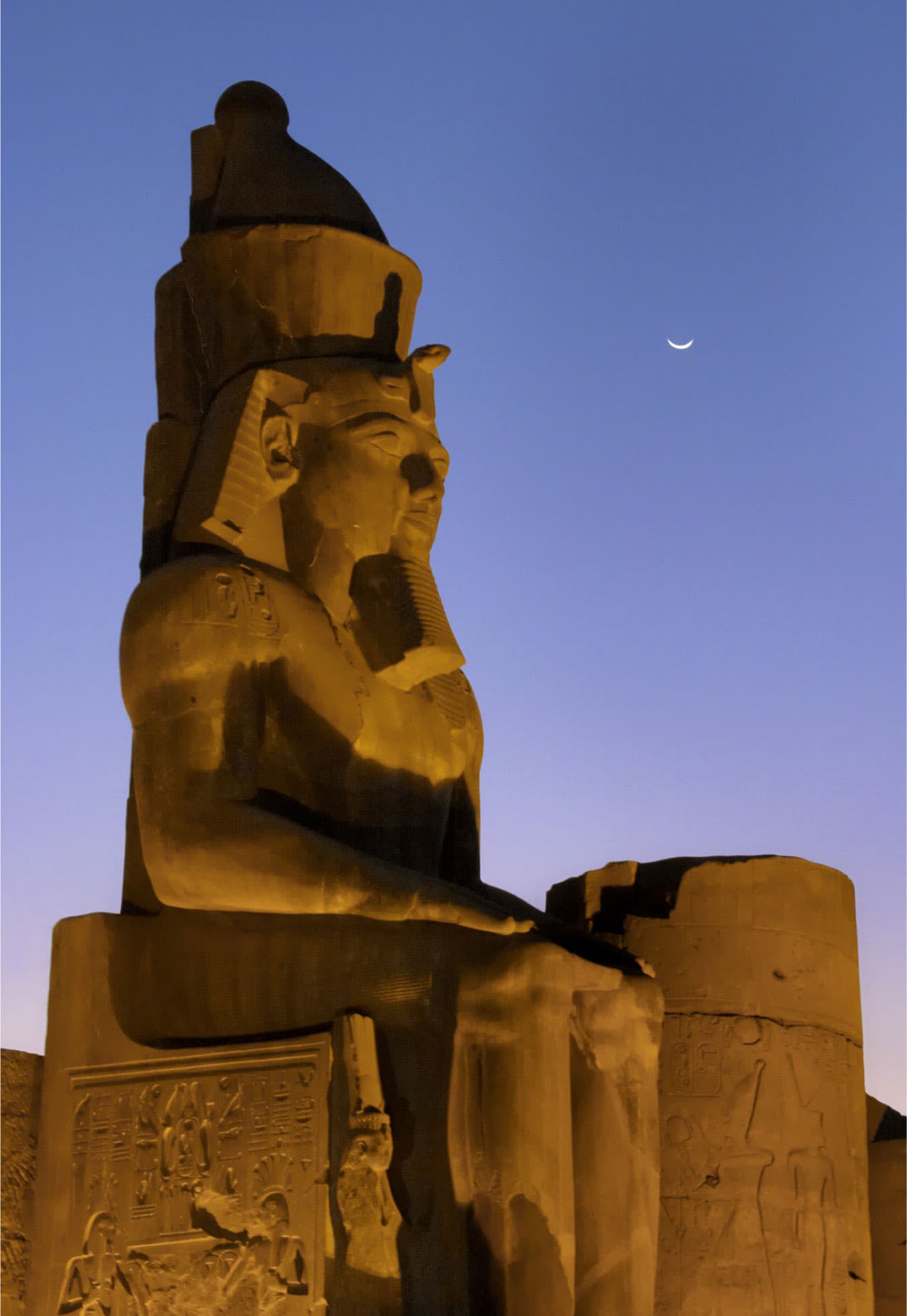
Luxor Temple, Luxor EGYPT
The new moon at dusk, above a colossal, 3400-year-old seated statue of Ramesses II at Luxor Temple in the ancient Egyptian city of Thebes. Now modern-day Luxor, the city lies on the east bank of the Nile River, some 500 km (300 miles) south of Cairo. Across the river are the Valley of Kings and the Valley of Queens, the burial sites of ancient pharaohs and their wives. Nearby, in the Deir el-Bahri temple complex, lies the tomb of Senenmut, where a masterpiece of ancient art and astronomy appears on the ceiling and depicts circumpolar constellations such as the Big Dipper alongside lunar cycles and sacred deities.
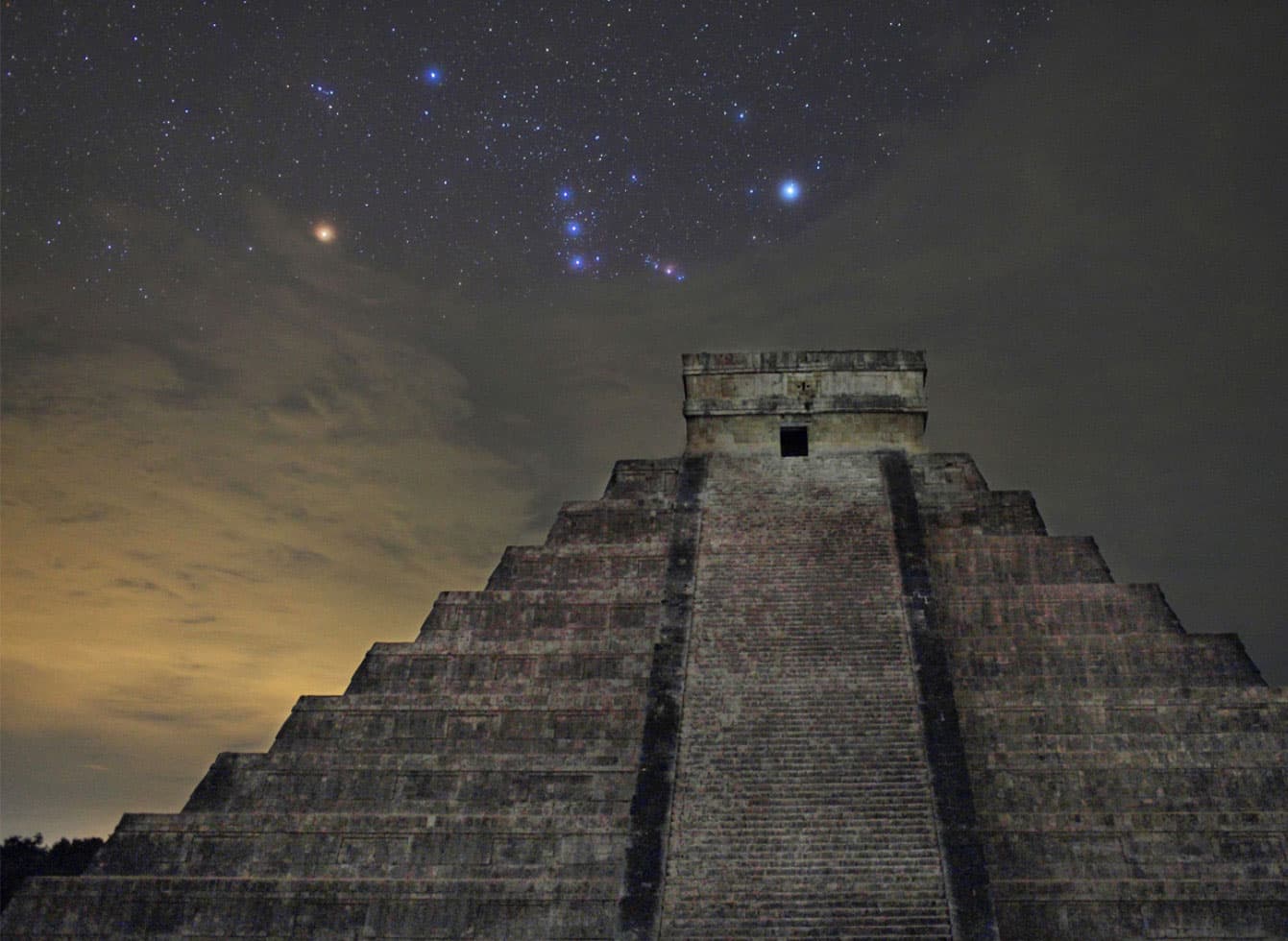
Chichén Itzá, Yucatán MEXICO
Orion (the Hunter) rises above the central pyramid at Chichén Itzá, a grand Mayan centre on the Yucatán Peninsula. Known as the Temple of Kukulkan, it stands 30 m (100 ft) tall and was built between the ninth and twelfth centuries. Noted for various astronomical alignments, it is thought that the Mayas – accomplished astronomers and mathematicians – used the cyclic motions of celestial bodies to measure time. They regarded the constellation of Orion as ‘heart of heaven’, representing it as a turtle.

Persepolis, Fars Province IRAN
One of the world’s most remarkable archaeological sites is Persepolis and the 2,500-year-old tombs of ancient Persian kings in Naqsh-e Rustam, both some 100 km (60 miles) northeast of Shiraz in modern-day Iran. This time-lapse exposure captures the rotation of sky around Polaris above the 60m (200ft) tall cliff with its massive cross-shaped tombs.

Uluru (Ayers Rock), Northern Territory AUSTRALIA
With the first-quarter moon setting in the west, the Milky Way appears prominently in the starry sky above Australia’s most recognizable landform. Uluru is a World Heritage site at the very heart of Australia – a single massive rock formation 348 m (1140 ft) above the plain. This monolith actually extends much further beneath the desert plain. The most sacred site to Aboriginal culture, it is home to ancient rock art depicting stories relating to the creation of the land and skies.

Chaco Canyon, New Mexico USA
The entire Chaco Culture National Historical Park is an International Dark Sky Park, a natural darkness zone with no permanent outdoor lighting. The night sky is deeply connected to the Native American Pueblo culture that has been handed down through the generations from the Ancestral Puebloans who inhabited the canyon from 900 to 1150 [CE]. Pictured here is the Casa Rinconada kiva, beneath a rising Milky Way. It is thought that certain alignments of this circular ceremonial gathering place relate to astronomical observations, allowing the Ancient Puebloans to use the site as a lunar or solar calendar.
NATURAL
In order to qualify for UNESCO’s elite World Heritage List, a natural location must meet some or all of the following criteria: it must be a superlative example of a natural phenomenon or an area of exceptional aesthetic importance; an outstanding representation of a major stage of Earth’s history, or of an ongoing geological process in the development of landforms; it must be an important natural habitat for the conservation of biological diversity. Given the nature of these requirements, it follows that most natural heritage sites are also far enough from major developments to benefit from dark night skies. Images in this category show how the natural beauty of the night-time environment is preserved in these protected sites. Sitting under an ocean of stars in the Grand Canyon or at the foot of Patagonia’s rugged Torres del Paine Mountains, it’s easy to imagine how the past generations in these locations enjoyed the beauty of the night sky above some of Earth’s most stunning landforms.
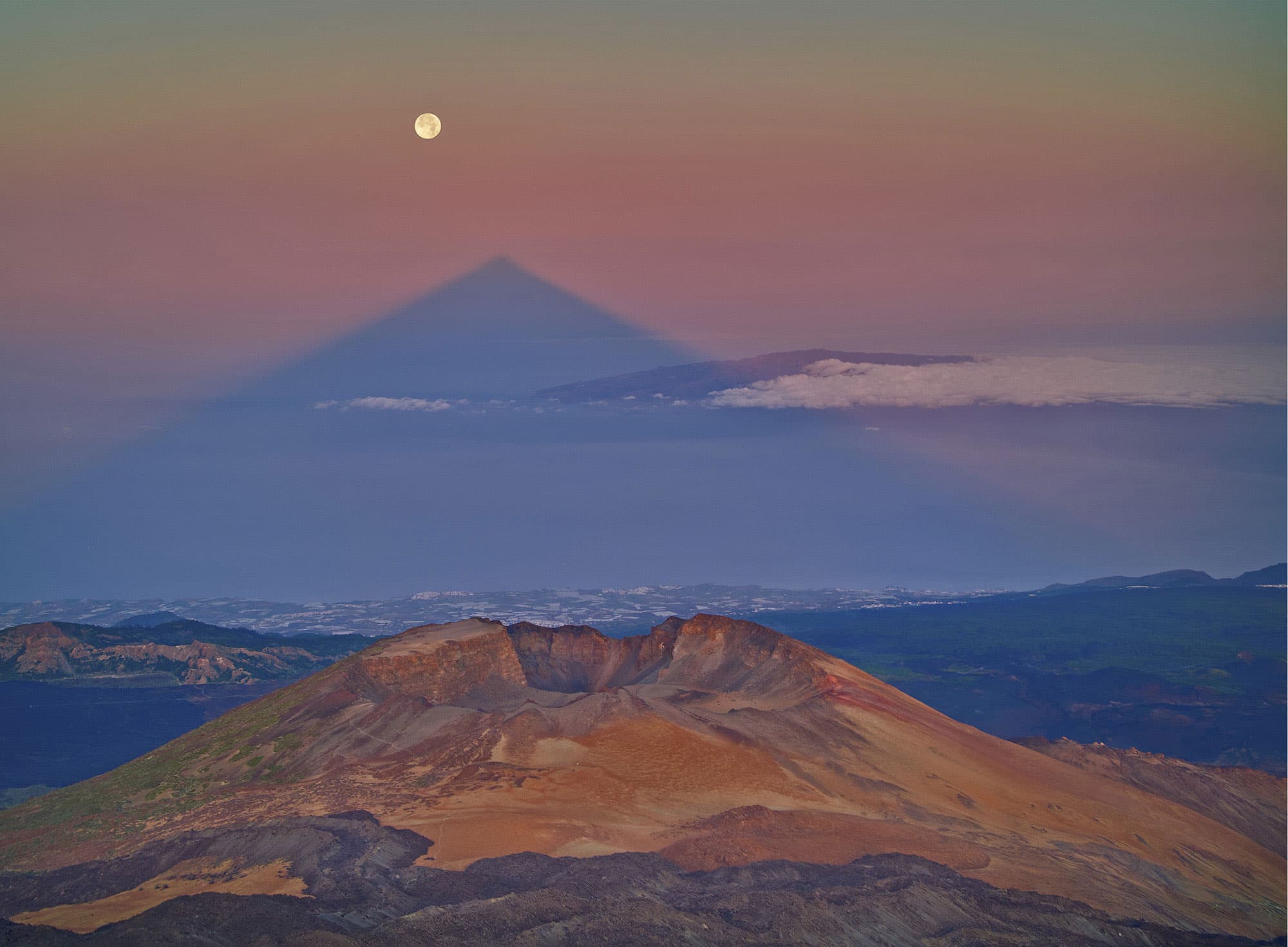
Tenerife, Canary Islands SPAIN
This exceptional capture of the full moon setting above Tenerife just at the start of sunrise was planned months in advance. The photograph was taken shortly after a total lunar eclipse in mid-June 2011, with the photographer standing on the top of Mount Teide. The island’s tallest peak, Teide is a magnificent volcano that reaches 3,718 m (12,198 ft) above sea level and some 7,500 m (24,600 ft) above the floor of the Atlantic Ocean. In the foreground is the crater of Pico Viejo, the island’s second-tallest peak and, beyond that, the shadow of Teide itself. There is an optical illusion at play here, specifically in the way that the shadow of this great mountain forms a perfect triangle. Teide does not have a strictly pyramidal shape – in fact, around 200,000 years ago, the cone-shaped summit of the volcano collapsed, creating a caldera. Still, the shadow persists, and is common to the shadows of other large mountains and volcanoes. A key reason for its shape is that the observer is looking down the long corridor of a sunset (or sunrise) shadow that extends to the horizon. As such, the edges of the mountain taper towards the vanishing point, just as parallel train tracks do.

Réunion SOUTH INDIAN OCEAN
The dreamlike scene depicts one of the most beautiful places on Réunion, a 70 km (43 mile) wide island, some 700 km (435 miles) east of Madagascar. The Piton de l’Eau is a crater filled with water and surrounded by arum lilies from July to September. Here, the setting Milky Way occupies the greater part of the sky, forming an arch over the Piton des Neiges volcano in the distance – the highest point in the Indian Ocean at 3,070 m (10,070 ft). Almost half of this French territory paradise island is protected as a natural World Heritage site, taking shape as La Réunion National Park with massive volcanic plugs (pitons), cliff-rimmed cirques, forested gorges and basins. At a latitude of 20 degrees south, the island’s well-preserved dark skies showcase the best of the southern sky wonders.

Jasper NP, Alberta CANADA
Above Athabasca Falls, amid high cirrus clouds, Pleiades star cluster (top) and the rest of the Taurus constellation with its bright-orange star, Aldebaran, appear in this October night at Jasper, the largest national park in the Canadian Rockies, north of Banff National Park. The two parks, known for their glaciers, hot springs, lakes, waterfalls and rugged mountains, are popular stargazing destinations.

Yellowstone National Park, Wyoming USA
Old Faithful geyser erupts under the stars on a summer’s night at Yellowstone, the first national park established in the United States (and worldwide), in 1872. This geyser erupts at intervals of between 60 and 110 minutes and can shoot 14,000 to 32,000 litres (3,000 to 7,000 gallons) of boiling water to a height of 30–55 m (100–180 ft). Here, stars of Ursa Major (the Big Bear) are right above the eruption. Wandering around Yellowstone at night, a photographer should also be aware of the big bears on the ground! The park is home to many grizzly bears.

Torres del Paine National Park CHILE
At a latitude of 51 degrees south, some 2,000 km (1,245 miles) south of Santiago, near the southernmost tip of the Americas, rests a small group of rugged mountains in Patagonia. These gigantic granite monoliths, the tallest reaching 2,884 m (9,460 ft) high, were shaped by the forces of glacial ice. On this February morning, planet Saturn (left) and bright star Arcturus (right) shine in twilight above the Paine Cuernos Mountains and Lake Pehoé in Torres del Paine National Park.

Grand Canyon National Park, Arizona USA
The Grand Canyon offers extremely dramatic scenes when caught at the right time and in the right light. The upper panoramic image ranges from west (left) to east, and captures the yellow-red light of early twilight a few minutes after the sunset, illuminating the canyon and the blue-purple colour of the rising Earth shadow on the right, at the opposite horizon (east). This is the shadow that Earth itself casts onto its atmosphere and into outer space. Above the Earth shadow, another atmospheric phenomenon forms – anticrepuscular rays directly above an extinct volcano that sits near the edge of the world’s longest canyon. This steep-sided gorge has been carved by the Colorado River over an approximately 17-million-year timespan. It is 446 km (277 miles) long and attains a depth of more than 1.6 km (1 mile). More than 1 million people spend a night in the Grand Canyon every year, with the sky spread out above them. The lower panorama shows a moonlit night in the park, with the stars glowing over the Desert View Watchtower. Planet Jupiter is the dazzling ‘star’ on the right.


Réunion SOUTH INDIAN OCEAN
The eruption of Piton de la Fournaise, a shield volcano on the eastern side of the island. With more than 150 recorded eruptions since the seventeenth century, this is one of the world’s most active volcanoes, along with Kīlauea on the island of Hawaii (pictured opposite).
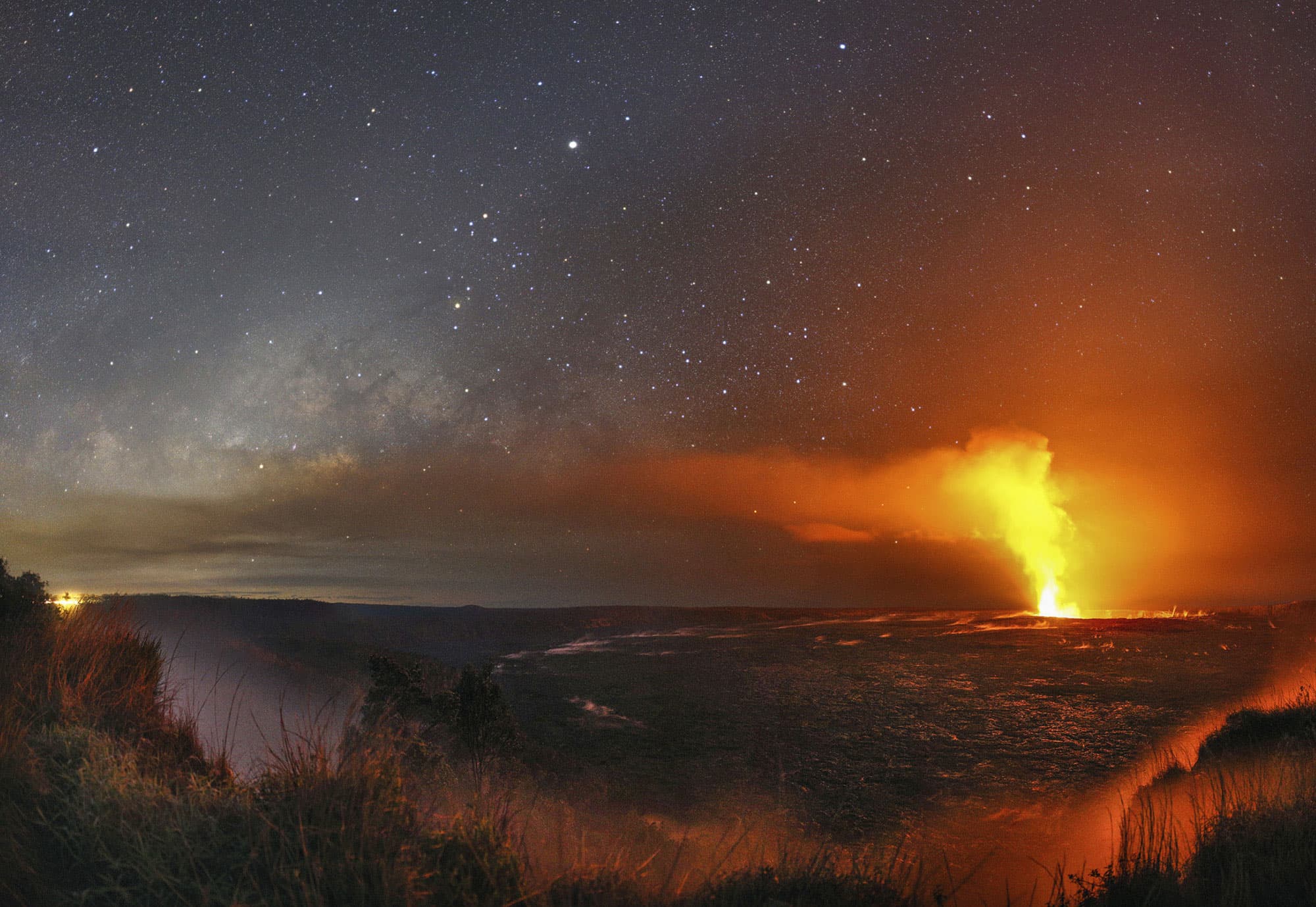
Hawaii Volcanoes National Park USA
The night sky over Kīlauea, a shield volcano on the island of Hawaii, also known as Big Island. On this late-January morning, a short window of totally dark sky between moonset and the onset of morning twilight allowed the photographer to capture the rising Milky Way above Halema’uma’u Crater, from a distance of 2 km (1.2 miles) away. Illuminated by the lava, the steam and smoke rising from the lava lake cause part of the sky to vanish.
HISTORIC
There are around 1,000 cultural and historic sites on UNESCO’s World Heritage List. Many of them are located within large cities, but there are a number to be found in more remote areas with minor light pollution. Preserving the common cultural heritage of humanity, these sites represent masterpieces of creative genius and exhibit the interchange of human values over centuries of time. Among the sites included in the list are those that display remarkable architecture, such as India’s Taj Mahal, often described as the most extravagant monument ever built for love. Others are selected for their unique contribution to a living or past civilization. The Belém Tower in Lisbon is an example of this, having played a significant role in the Portuguese maritime explorations of the sixteenth century. Venice is another fine example – also with a maritime connection – an entire living city where humankind has long had a precarious interaction with a most fragile natural environment. Remnants of a civilization’s cultural past also qualify, as in the curious monolithic stone heads on Easter Island or the Great Wall of China, built out of the necessity to defend Chinese territory for many centuries. Such examples can be found on all of Earth’s inhabited continents, spanning thousands of years of human civilization. It is every nation’s desire to add a cultural site to this prestigious list. Such an honour brings an increasing number of remarkable sites to the attention of the wider public, generating income for the host country, but also raising public awareness and sharing in humankind’s growing desire to preserve the irreplaceable.

Taj Mahal, Agra INDIA
Stars of Orion (the Hunter) set above the Taj Mahal, with the three ‘belt’ stars visible near the centre of the image. The combined photo sequence captures Earth’s rotation during the course of an hour. The skies of populated cities like Agra are light polluted and often dusty, but this sequence was shot after a cleaning rain and strong winds had cleared the air, leaving an exceptionally clear night. Still, for bright urban skies, it is much more practical to record them using a stacked sequence of short-exposure photos, instead of one single over-exposed image.

Rapa Nui National Park, Easter Island CHILE
On this isolated island in the Pacific Ocean, large statues called Moais stand silhouetted against the southern Milky Way. Dating from the thirteenth to the fifteenth centuries, these monolithic stone heads were made in their hundreds. The pictured set is known as Ahu Tongariki in the Rapa Nui (Easter Island) National Park. The patchy clouds to the right are neighbouring satellite galaxies, the Large and Small Magellanic Clouds, each several billion times the mass of our sun. The smaller of the two is the furthest object visible in this view at 200,000 light years away. Its light belongs to a time when there was no civilization on our planet.

Wat Mahathat, Sukhothai THAILAND
The Milky Way and Venus hang high above a large Buddha statue at the temples of Sukhothai in Thailand. Dazzling Venus resembles a supernova explosion in our galaxy, a phenomenon that has not been observed for more than four centuries. The ancient tropical site of Sukhothai, meaning ‘dawn of happiness’, was the capital of a kingdom of the same name during the thirteenth and fourteenth centuries. Pictured here is Wat Mahathat, the ‘Temple of the Great Relic’. This most significant part of Sukhothai was built on the concept of the mandala, an ancient Hindu symbol representing the universe.

Metéora GREECE
Located near the town of Kalambáka in central Greece, Metéora is the scene of a cluster of monasteries, precipitously built on (or inside) pillars of natural sandstone. With a name that derives from a contraction of the Greek for ‘suspended in air’, this extremely isolated complex is one of the world’s largest Eastern Orthodox monasteries. Some are around 1,000 years old. Here, at the centre of the image, Venus shines elegantly in a colourful dusk on the western horizon, an hour before the star-filled sky embraces this otherworldly site.

Belém Tower, Lisbon PORTUGAL
This photograph of the iconic landmark of Lisbon, the Belém Tower, takes advantage of a rare occasion on which its security floodlights were turned off. Otherwise, capturing stars above this strongly lit monument is not possible in the dynamic range of a single-exposure image. Constellation Taurus (the Bull) with the Pleiades star cluster and Jupiter (brightest point) appear to the left of the image, above the 25 de Abril Bridge. The tower is a fortified structure, a defence system at the mouth of the Tagus River and a ceremonial gateway to Lisbon.

Great Wall, Hebei Province CHINA
The central region of the Milky Way and planet Saturn (brightest point) are framed through a window of the Jinshanling section of the Great Wall of China, Hebei province. The wall was built and rebuilt in periods from the seventh century [BCE] to the sixteenth century [CE]. Its purpose was to protect the Chinese states and empires against the raids and invasions of nomadic groups, primarily from Mongolia. This wall is the world’s largest military structure with a total length of more than 20,000 km (12,500 miles) and runs along an east-to-west line across the historical northern borders of China.
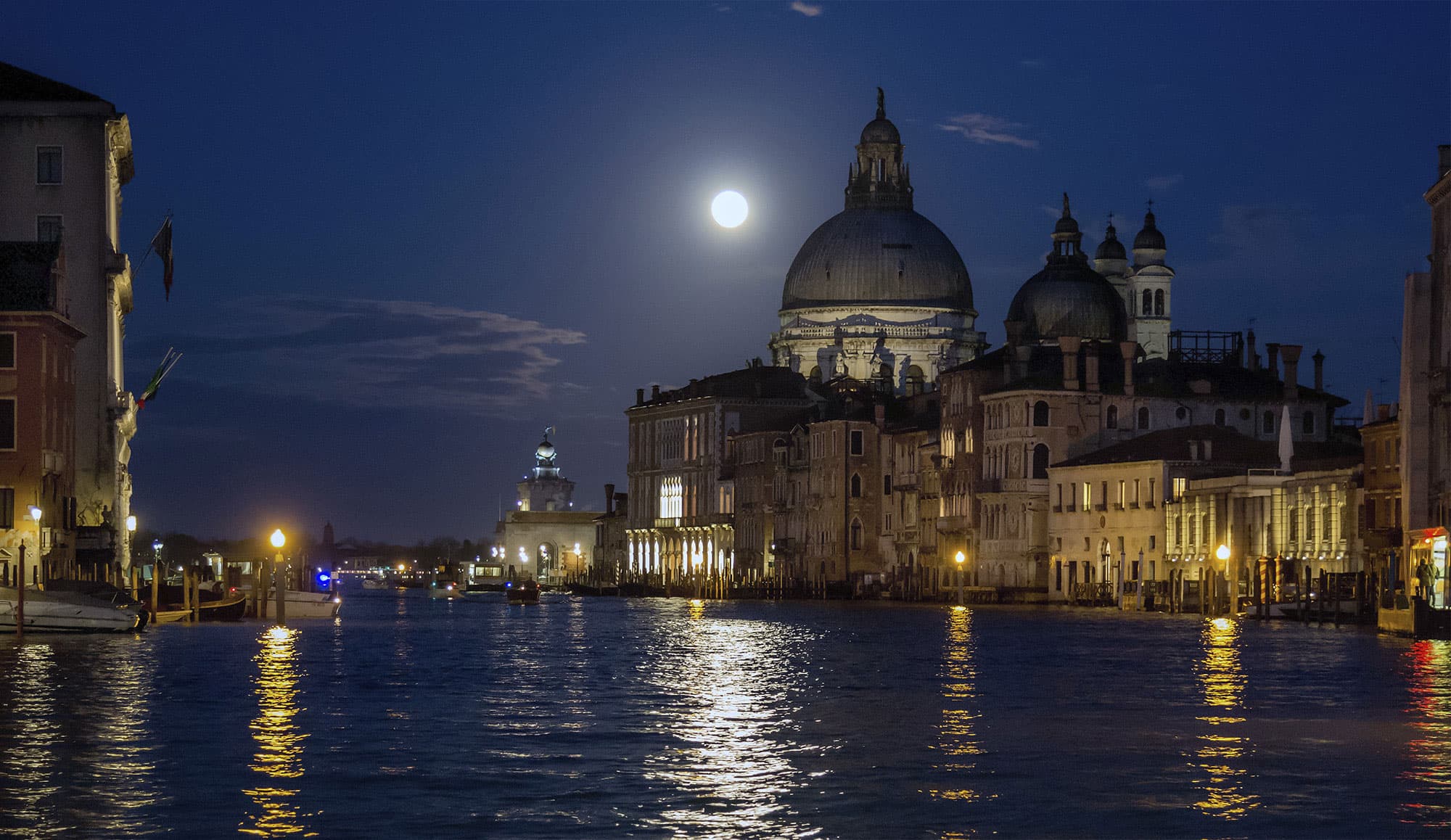
Venice ITALY
Gondolas float at night as the full moon shines on the Canal Grande and Santa Maria della Salute church in Venice. While the incredible, dynamic range of the human eye can detect very faint and very bright lights at the same time, revealing stars, landscape and details of the lunar disc in one glance, it is impossible for camera technology to replicate this in a single exposure after dark. Attempts to do so can lead to overexposure, resulting in an intensely bright full moon, as here.